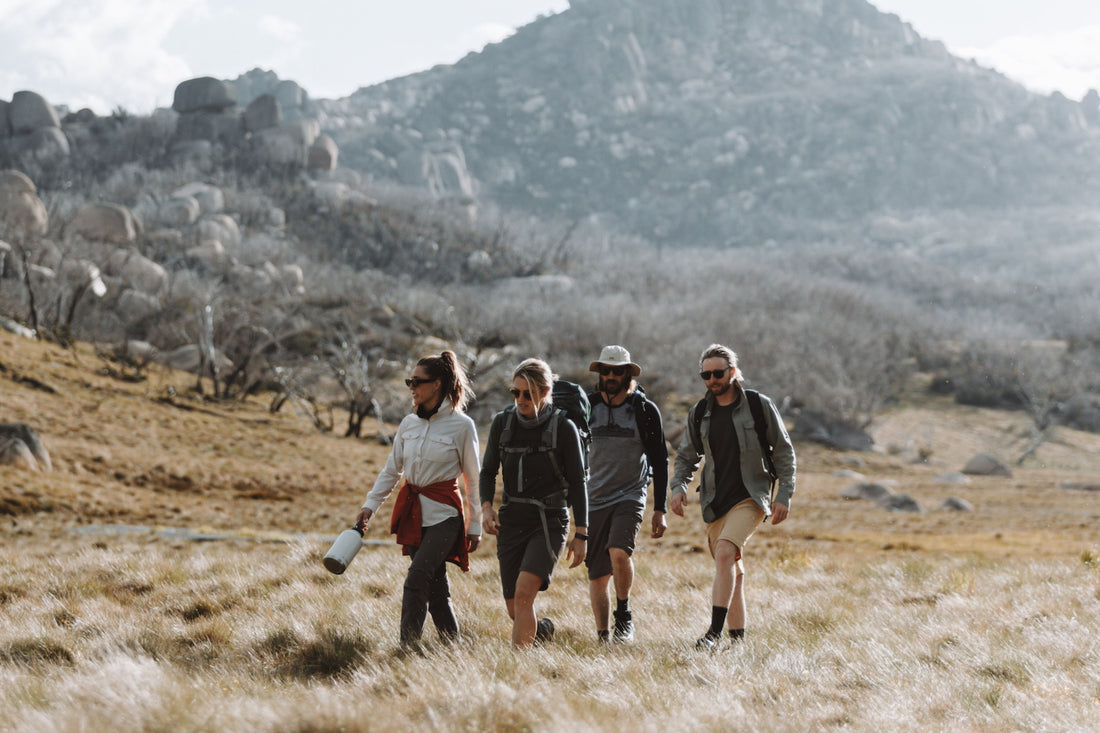Before you clock off work and clock onto mountain time, it’s a good idea to do a gear check on your hiking clothes. What you wear hiking can be the difference between good vibes or bad times. So, to help you on your way, we’ve collated a trail-worthy wardrobe checklist that’ll prepare you for whatever Mother Nature throws at you.
Hiking Clothes: The Basics
Hiking Pants
Let’s start from the bottom up. When it comes to hiking pants, you’ll want something durable, comfortable, and made for the terrain you’re tackling. What we’re saying here is - put away the jeans.
Instead, look for pants in breathable and lightweight fabrics. Zip-off hiking pants are often a winner, given your the versatility to choose between full-length pants and shorts as temps change throughout the day. Or for the ladies, a great option is hiking tights for activewear comfort loaded with extra benefits.
Hiking Shirts
Opt for a lightweight, collared long sleeve shirt to protect you from those harsh sun rays. A good option is to also layer it with a breathable base layer tee. Opt for tops made from sustainable fibres like Merino or Tencel since they are breathable, thermogenic and odour-resistant. Plus, you can sleep better at night knowing they are naturally packed with planet-friendly benefits.
Wondering why we didn’t mention cotton? Clothes made with cotton can get real stinky, real quick and don’t have the level of breathability that Merino and Tencel blends offer. It’s always best to avoid this fibre when it comes to sweaty escapades.
Layering for Hiking
Want to know a secret? The key to staying comfy on a hike is all in the layers.
Layering allows you to adapt to variable weather conditions and your own body temp changes. Here’s how to do it right:
- Base Layer: Aussie Merino or Tencel blends are perfect as base layers. They’re soft, sweat-wicking and naturally odour-resistant. Plus, they’ll keep you warm in cool conditions and cool when it gets hot.
- Insulation Layer: This is mostly needed for cool weather or overnight hikes. A lightweight insulation layer like a puffer or fleece can give you that extra hit of warmth when needed.
- Outer Layer: No matter how many times you check the forecast, Mother Nature can throw a spanner in the works. Always travel with a windproof, waterproof outer layer, like a rain jacket, to keep you dry and protected from the elements.
- Accessories: Don’t forget about your extremities. Merino wool hiking socks will do the trick for a comfy, blister-free hike. A hat or beanie to throw on your head and a set of Merino or windproof gloves will always come in handy (see what we did there), allowing extra protection when it's needed.
Some extra Hiking Tips
We know this is an article about what to wear hiking but we couldn’t resist sprinkling in some extra tips to help you on your way.
Hiking Boots
Invest in a sturdy pair of hiking boots or trail shoes with plenty of good traction. Doing this helps prevent any slips and falls, because really, aint nobody got time for that.
Sun Protection
No matter what the season, stay protected from those harsh UV rays with plenty of sun protection. Always pack some sunscreen, a hat, and don’t forget those sunnies.
Drink Up
No, we don’t mean that hip flask of whisky. Hydration is key on any hike so bring plenty of water for your trip to keep those fluids up.
Backpack
No matter what trail you choose, it’s always best to pack a backpack with the essentials like sun protection, water, and plenty of snacks. We’d also suggest throwing in a small medical kit or even some bandaids. Just in case.
Time to get high (in altitude, that is)
From your choice of hiking pants, shirts and even down to your socks, the right gear can make all the difference on your next trip into the wild. So, don’t forget to layer up with terrain and weather conditions in mind, because life’s better spent on the trails.
Need more? Check-out our article Hiking 101: All You Need To Know.
Happy Hiking!

